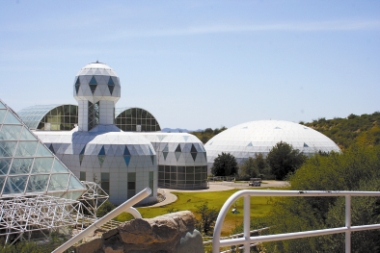
生物圈二号探秘 Jane Poynter and seven Americans agreed to spend two years sealed inside a 3-acre terrarium* in the Sonoran Desert. Their mission back in the 1990s: To see whether humans might someday be able to create self-sustaining* colonies* in outer space. Two decades later, the only creatures living in Biosphere 2 are cockroaches*, nematodes*, snails, ants and fish. Scientists are still using the 662,000-square-meter facility, only now the focus is figuring out how we’ll survive on our own warming planet. Next month, workers will begin a new chapter for “B2” — building the first of three enclosed soil slopes in what was once the “intensive agricultural biome,” the space where Poynter and the other original “biospherians” grew the rice, sorghum*, peanuts, bananas, papayas*, sweet potatoes and lablab beans* that satisfied 90 percent of their nutritional needs. The new “Land Evolution Observatory” — a 10-year, US$5-million project — will help scientists learn how vegetation, topography* and other factors affect rainwater’s journey through a watershed and into our drinking supplies. And researchers say Biosphere 2 may be even more important today than when those first people passed through the airlocks on September 26, 1991. Located about 48 kilometers northeast of Tucson in the foothills of the Santa Catalina Mountains, B2 rises out of the high-desert landscape like a giant glass-and-steel ziggurat*. In a story previewing that first mission in 1991, The New York Times described it as a “combination greenhouse and futuristic shopping mall.” The facility at SunSpace Ranch contained five different ecosystems, or “biomes:” A mangrove* wetland, tropical rain forest, savanna grassland, coastal fog desert, and a 600,000-gallon “ocean” with its own wave-lapped sand beach and living coral reef*. All told, nearly 4,000 species of animals and plants lived there. The building itself — with its network of 52 tanks that collected up to 5,000 gallons of water from the air each day and “rained” it back into the various biomes, and two massive domed “lungs” that kept the airtight building from exploding or imploding as outside temperatures changed from below freezing to more than 40 degrees Celsius — was an engineering marvel. Project officials had boasted that B2 was more airtight than the space shuttle. But by December, tests showed significant leakage*, and outside air had to be pumped in. Over time, oxygen levels inside B2 had dropped to dangerous levels. There were explosions in the cockroach and ant populations. The coral reef died. Today, B2 itself has been recycled. Everywhere you look, there are experiments going on. And, as it has been from the beginning, B2 is a major tourist attraction. (SD-Agencies) | 
